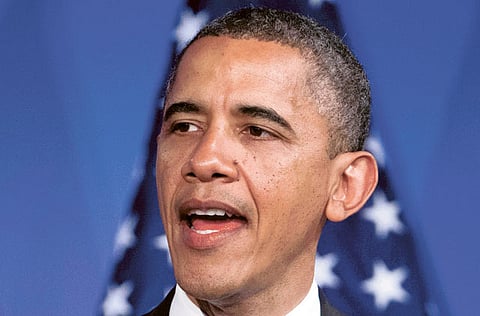The drone war is Obama’s war
A decade ago, critics warned that the “war on terror” would spread terrorism rather than stamp it out. That is exactly what happened

More than a decade after George W. Bush launched it, the “war on terror” was supposed to be winding down. US military occupation of Iraq has ended and Nato is looking for a way out of Afghanistan, even as the carnage continues. But another war — the undeclared drone war that has already killed thousands — is now being relentlessly escalated.
From Pakistan to Somalia, CIA-controlled pilotless aircraft rain down Hellfire missiles on an ever-expanding hit list of terrorist suspects. They have already killed hundreds, perhaps thousands, of civilians in the process.
At least 15 drone strikes have been launched in Yemen this month, as many as in the whole of the past decade, killing dozens. In Pakistan, a string of US attacks has been launched against supposed “militant” targets in the past week, incinerating up to 35 people and hitting a mosque and a bakery.
The US’s decision to step up the drone war again in Pakistan, opposed by both government and parliament in Islamabad as illegal and a violation of sovereignty, reflects its fury at the jailing of a CIA agent involved in the Osama Bin Laden hunt and Pakistan’s refusal to reopen supply routes for Nato forces in Afghanistan. Those routes were closed in protest at the US killing 24 Pakistani soldiers last November, for which Washington still refuses to apologise.
Wajid Shamsul Hassan, Pakistan’s High Commissioner in London, described the latest US escalation as “punitive”. But then Predators and Reapers are Barack Obama’s weapons of choice and coercion, deployed only on the territory of US allies like Pakistan and Yemen — and the drone war is Obama’s war.
In his first two years in office, the US president more than tripled the number of attacks in Pakistan alone. For their US champions, drones have the advantage of involving no American casualties, while targeting the “bad guys” that Bush lost sight of in his enthusiasm to subjugate Iraq. Enthusiasts boast of their surgical accuracy and exhaustive surveillance, operated by all-seeing technicians from thousands of miles away in Nevada.
But that’s a computer-game fantasy of clinical war. Since 2004, between 2,464 and 3,145 people are reported to have been killed by US drone attacks in Pakistan, of whom up to 828 were civilians (535 under Obama) and 175 children. Some Pakistani estimates put the civilian death toll much higher — plausibly, given the tendency to claim as “militants” victims later demonstrated to be nothing of the sort.
The US president insisted recently that the civilian death toll was not a “huge number”. Not on the scale of Iraq, perhaps, where hundreds of thousands were killed; or Afghanistan, where tens of thousands have died. But they gruesomely include dozens killed in follow-up attacks after they had gone to help victims of earlier strikes — as well as teenagers like Tariq Khan, a 16-year-old Pakistani boy decapitated in a strike last October after he had travelled to Islamabad to protest drone attacks.
These killings are, in reality, summary executions and widely regarded as potential war crimes by international lawyers — including the UN’s special rapporteur on extra-judicial killings, Philip Alston. The CIA’s now-retired counsel, John Rizzo, who authorised drone attacks, himself talked about having been involved in “murder”.
A decade ago, the US criticised Israel for such “extra-judicial killings”, but now cites self-defence as the logic to justify the war against Al Qaida. However, these are attacks, routinely carried out on the basis of false intelligence in countries such as Pakistan where no war has been declared and without the consent of the elected government.
Lawyers representing victims’ families are now preparing legal action against the British government — which carries out its own drone attacks in Afghanistan. Parallel cases are also being brought against the Pakistani government and the drone manufacturer General Electric — whose slogan is “we bring good things to life”.
Of course, drone attacks are only one method by which the US and its allies deliver death and destruction in Afghanistan and the wider Middle East, from night raids and air attacks to killing-sprees on the ground. The day after the Al Houla massacre in Syria, eight members of one family were killed at home by a Nato air attack in eastern Afghanistan — one of many such atrocities barely registered in the western media.
While support for the war in Afghanistan has fallen to an all-time low in all Nato states, the drone war is popular in the US. That’s hardly surprising as it offers no danger to American forces — the ultimate asymmetric warfare — while supposedly “taking out” terrorists. But these hi-tech death squads are creating a dangerous global precedent which will do nothing for US security.
A decade ago, critics warned that the “war on terror” would spread terrorism rather than stamp it out. That is exactly what happened. Obama has now renamed the campaign “overseas contingency operations” and is switching the emphasis from boots on the ground to robots.
But, as the trouble in Pakistan and the growth of Al Qaida in Yemen shows, the impact remains the same. The drone war is a predatory war on the Muslim world, which is feeding hatred of the US — and fuelling terror, not fighting it.
Sign up for the Daily Briefing
Get the latest news and updates straight to your inbox


